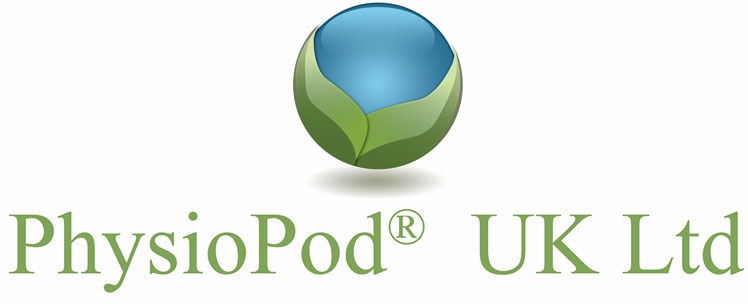Case Study: Use of Deep Oscillation in Secondary Lymphoedema of the Head and Neck
By Christine Talbot SRN Lymphoedema Practitioner
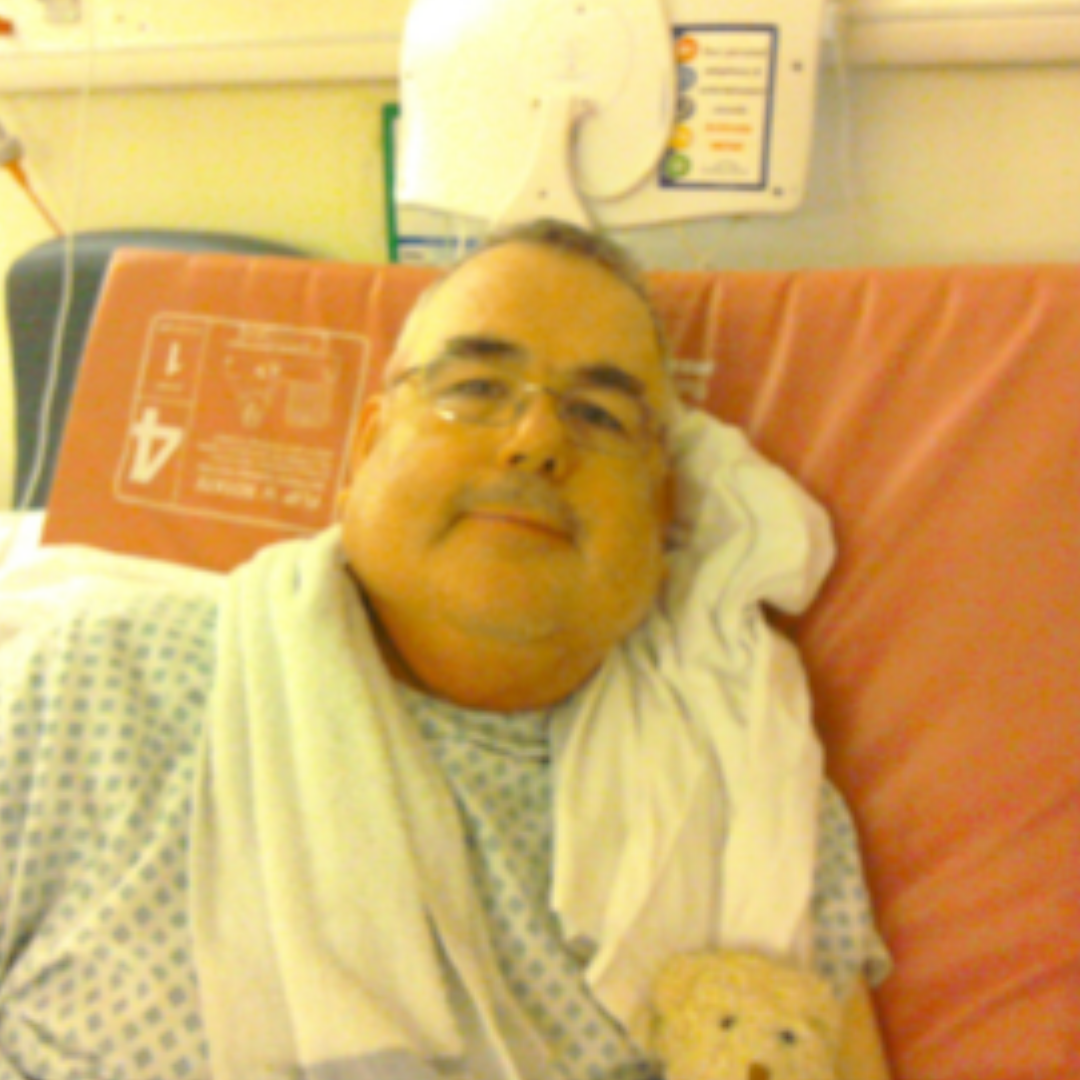
Mr A Prior to surgery - February 2016
Background Information
Mr A, aged 67 had been diagnosed in June 2015 with Squamous Cell Carcinoma in right base of tongue with extensive metastatic disease (T1 N2c).
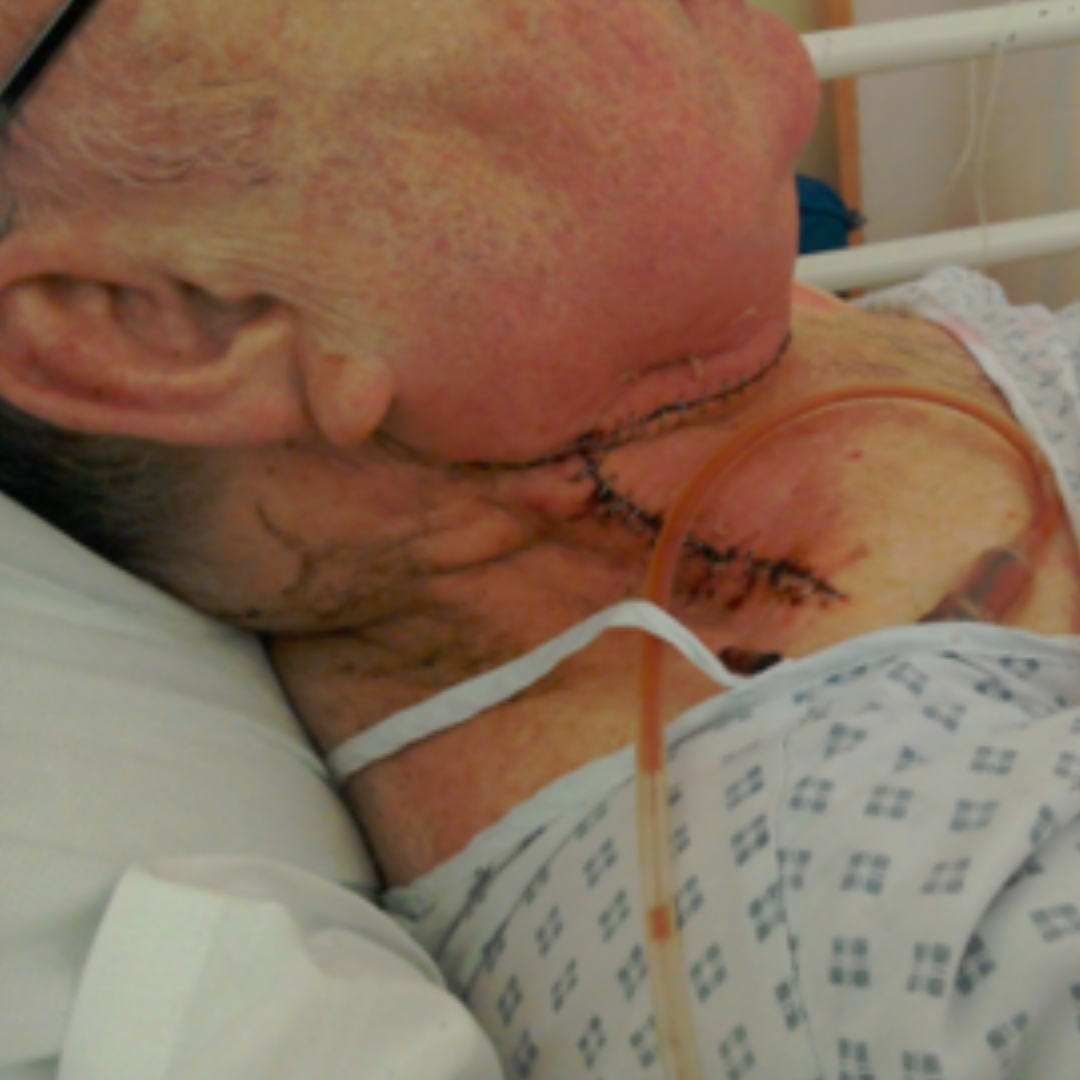
Mr A post surgery - February 2016
He had facial neck swelling prior to and secondary to cancer treatment including chemotherapy, radiotherapy and complete bilateral lymph node dissection in February 2016. The swelling was complicated by recurrent cellulitis infection with persistent left otorrhea and left otalgia. He suffered ongoing recurrent head and neck cellulitis infections +/- otitis externa/media.
Mr A had noticed progressive development of head and neck swelling six months prior to his diagnosis in June 2015. The swelling deteriorated following treatment and he was referred to and initially overseen for a Lymphovascular dermatological review for his extensive head and neck lymphoedema at St Georges’ Hospital London.
Initial Advice from Consultant
- Mr A and his wife were instructed on how to apply Kinesio-tape to give some directional flow to the lymphoedema
- Yoga-type, deep breathing exercises were encouraged to help stimulate and encourage global lymphatic flow
- Simple lymph drainage (SLD) was also demonstrated
- Advised to remain as active as possible and to lose some weight
Physical Presentation: 07.06.2018
Mr A presented with significant lymphoedema to his face in particular graduating to his left ear and cheek, with a persistent, bulbous collection in the pre and post auricular area subject to repeat episodes of cellulitis for which he was prescribed Penicillin V 500mgs and other antibiotics for sudden flare ups. For a multitude of reasons; Mr A did not find SLD easy or particularly effective and because his facial skin is in parts hypersensitive he reacted badly to the Kinesio-taping with regular outbursts of contact dermatitis.
Exercise and keeping active were difficult, as he was always in a great deal of pain and suffered with extreme fatigue. Mr A is further hampered by constant, significant pain from a work-related accident years ago, resulting in decompression of his spine and shoulder impairment due to surgery. Mr A’s food intake is minimal, as he had no taste and difficulty swallowing, initially he was ‘peg fed’ and did lose a fair amount of weight.
Mr A was prescribed with a catalogue of medication, which made him feel ill, which further impedes his ability to exercise, leaving him very depressed and despondent. The constant and severe pain to the head and neck had resulted in troubling headaches, his whole-body frame was fairly rigid and he could barely move his head and neck. His sleep was most erratic due to pain and the inability to position himself comfortably. His speech was affected and it was difficult at times to understand what he was saying. He was profoundly fatigued, very depressed, anxious and distressed and very mistrustful of manual lymphatic drainage either to receive it or that there would be any benefit to its outcome. The overall impact on his and his wife’s quality of life is immense and is none other than a repetitive round of appointments from one hospital department to another.
Two years on from surgery, I was surprised by Mr A’s very limited range of movement, he was unable to rotate his head, to do any flexion and extension from his chin to neck and could not move his tongue around his mouth or put his tongue out of his mouth. His whole frame appeared a solid, immovable mass. He was clammy, frequently needing to wipe his face and mouth, he was not febrile but the discoloured purple reddish appearance to the left side of his face and in particular, the red significantly bulbous lymphatic engorgement to his post auricular nodes and ear was hot and of concern. At this time, he was attending Poole Hospital ENT for two to three-week evacuations of the ear canal which did relieve some of his discomfort and the excessive build-up of pressure inside his head and face.
He did not enjoy food, he could not taste food, he was fatigued by the whole process of mastication and very fearful of bronchial aspiration which had occurred on several occasions.
Initial Treatment Plan:
- To soften and aid cellular repair along the extensive rigid, taught neck scarring, as this rigidity impeded head and neck mobilisation, intra oral movement with associated significant mastication and speech impairment.
- To relieve the facial and auricular swelling encompassing the left cheek, ear and post auricular node area.
- To improve overall trunk and upper limb pain and stiffness.
Methodology
Therapy: Quantum Wave Laser: infra-red, red and ultraviolet combined
Protocol: Lymphatic and scar setting to neck scarring, left cheek and pre and post auricular nodes.
Duration: 20 minutes
Therapy: Manual Lymphatic Drainage and Deep Oscillation using HIVAMAT® 200
Method: Vodder for skin stretching, Fill and Flush for cheeks and eyes, remainder
Casley Smith MLD. Indian Head Massage is also utilised in combination with Deep Oscillation including: scalp lifting, gentle hair tugging and massaging around the hairline and particularly the occipital area
Application: Gloved hands, then 5cm applicator head and 9.5 cm applicator head
Protocol: Carried to trunk, bilateral axilla, back, neck, scalp and face.
Frequency: 200 Hz - 184 Hz
Mode: 5 – Intense vibration
Intensity: 100%
Duration: 1 hour in conjunction with laser
Therapy: Bowen Therapy: involves the movement of soft tissue in a specific way
Protocol: Shoulder procedure initially, progressing through the months to include respiratory, upper respiratory and TMJ.
Duration: 15-20 minutes
Pre-Treatment Mobility Assessment:
- Tongue extension barely protruded out from the bottom lip
- Head rotation poor to left and right
- Unable to put chin to chest
- Extremely limited rotation of arms on an extended lateral plane but could perform forward and upward arm raises to a degree. The arm, shoulder impediment would make self-lymphatic drainage difficult and painful to perform.
Initial Treatment Physical Assessment
Very anxious, sweating, mopping mouth with a cloth, turned whole body when being addressed, exhausted, shallow breathing, no facial animation, significant generalised and persistent head and neck pain, firm facial and neck swelling very pronounced on the left cheek, ear and bulbous swelling behind the left ear, these areas were reddened, hot to the touch and moist.
Post Treatment Result
Treatment was surprisingly well tolerated especially around the left ear. The tongue extended to well below the bottom lip, head rotation was significantly improved whereby chin to chest was performed with greater ease. No noticeable change to arm extension and rotation.
Practitioner Assessment
Mr A was markedly less anxious by the end of the treatment, his breathing and sweating had calmed down and he was surprised at his ability to tolerate Deep Oscillation Therapy. The treatment lasted approximately ninety minutes including the assessment, it was remarkable that a very different physical presentation walked out as had walked in. Mr A reported some relief of the pressure and pain behind the left ear and face. At the end of the first treatment Mr A and his wife were advised to thoroughly oil the scar with Argan oil and instructed how to do all facial and mouth exercises. Later that day Mr A’s wife rang to say he had been able to taste his food for the first time and although extremely tired was resting peacefully.
Effects of Subsequent Treatments

Deep Oscillation treatment commenced in June 2018. This photo was taken in February 2019 and shows Mr A's face taking more shape, underneath chin and jaw line
The immediate, initial change has become cumulative over time with ongoing treatments, in particular, Mr A has full animation of his face, he has good facial and intra oral movement, his speech is completely unimpeded, more specifically Mr A has not had any further episodes of cellulitis since the onset of treatment and the bulbous, hot, reddened swelling posterior to the left ear has practically resolved, the necessity for aural evacuation is far less frequent.
Mr A was asked to complete a PhysioPod Patient Questionnaire regarding Deep Oscillation (DO), results below, his additional comments in italics.
Do you feel that regular treatment with Deep Oscillation has improved the following areas, please answer, yes, no, n/a and provide any other relevant information?
- Swelling of the eyes, face, lips neck or area below the chin: Yes
- Discomfort/tightness/difficulty moving neck, jaw of shoulders: Yes
- Scarring (fibrosis) of the neck and facial skin: No (Immediately after D.O. treatment the benefits last 3-7 days only)
- Vision due to reduction in swelling of eyelids: Yes
- Swallowing: No. Current appointments with hospital speech and language therapist are investigating ways to help with this.
- Speaking: Yes. There has been a vast improvement as a direct result of D.O.
- Breathing: N/A
- Hearing, reduced Tinnitus/Cellulitis: Yes. Alongside D.O. the four-weekly vacuuming of the left ear by the hospital Aural Nurse to remove dried lymph fluid leakage has helped.
- Drooling or loss of food from the mouth whilst eating: Yes. Eating has improved vastly as my jaw is now better aligned, but I still have drooling.
- Nasal Congestion: N/A
- Has the treatment improved or relieved numbness and tingling: Yes. Still experience migraine, which is due to other factors
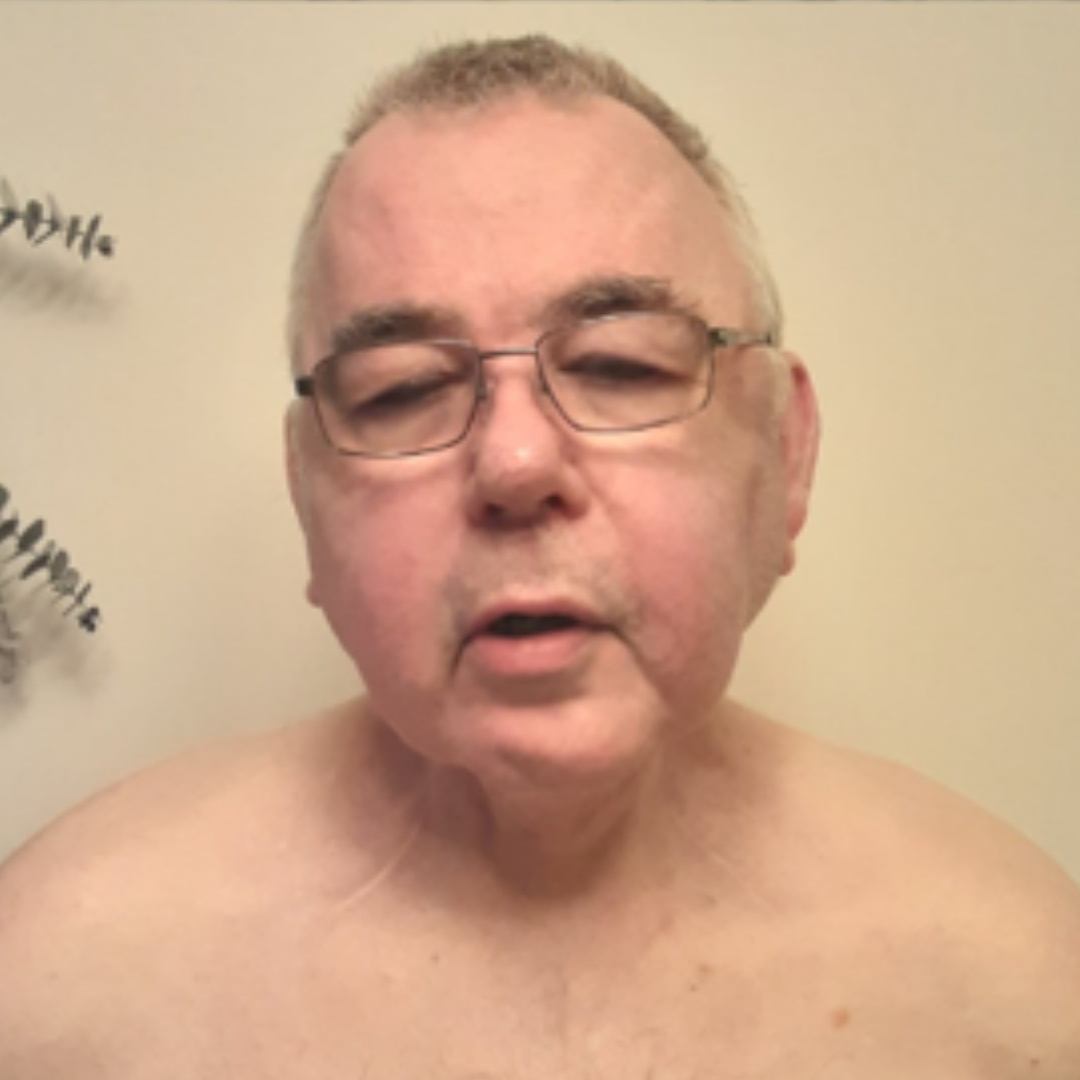
February 2020: Right posterior occipital and neck area much softer and a good colour
Patient Conclusion
“Deep Oscillation has improved my overall quality of life and has helped me manage the ongoing late side effects of head and neck cancer treatment and surgery. I would not have been able to cope with the ongoing effects of radiotherapy without Deep Oscillation treatment from my MLD therapist. I have recently tried treatment periods of three, four and five weeks and I have found a definite reversal of the benefits of Deep Oscillation treatment in week five. Therefore, monthly four weekly sessions are the most effective for me. Immediately after Deep Oscillation I feel brilliant and get a very good quality of sleep that night”.
Practitioner Conclusion
Mr A has shown great fortitude during his eighteen months of treatment with Deep Oscillation, his significant improvement is self-evident with regards to mobility, speech, facial expression, the ability to enjoy food as much as possible, a greater quality of sleep and more recently the desire and ability to attend a “Men's Shed” group, a weekly social for men. In my opinion, this is a great achievement towards gaining independence and self-worth outside of the endless rounds of medical appointments for him and his wife.
Acknowledgement
It is with deep regret that we announce the passing of Mr. A, the subject of this case study, in March 2023. We extend our sincere gratitude to his wife for her invaluable cooperation and for granting permission for the publication of this case study and the use of his photographs. These visuals serve to illustrate the significant benefits of DEEP OSCILLATION® therapy for individuals living with head and neck lymphoedema, a cause Mr. A was particularly keen to advocate.
This case study was originally prepared for inclusion in a chapter on "advanced treatments" within an international Lymphoedema publication. However, the planned book project was subsequently cancelled due to the COVID-19 pandemic.
Furthermore, our appreciation is extended to Christine Talbot for her diligent work in compiling this case study and her exceptional attention to detail.
Mary Fickling and Julie Soroczyn, Directors and Sisters of PhysioPod® UK
DEEP OSCILLATION® Therapy in the Management of
Head and Neck Lymphoedema
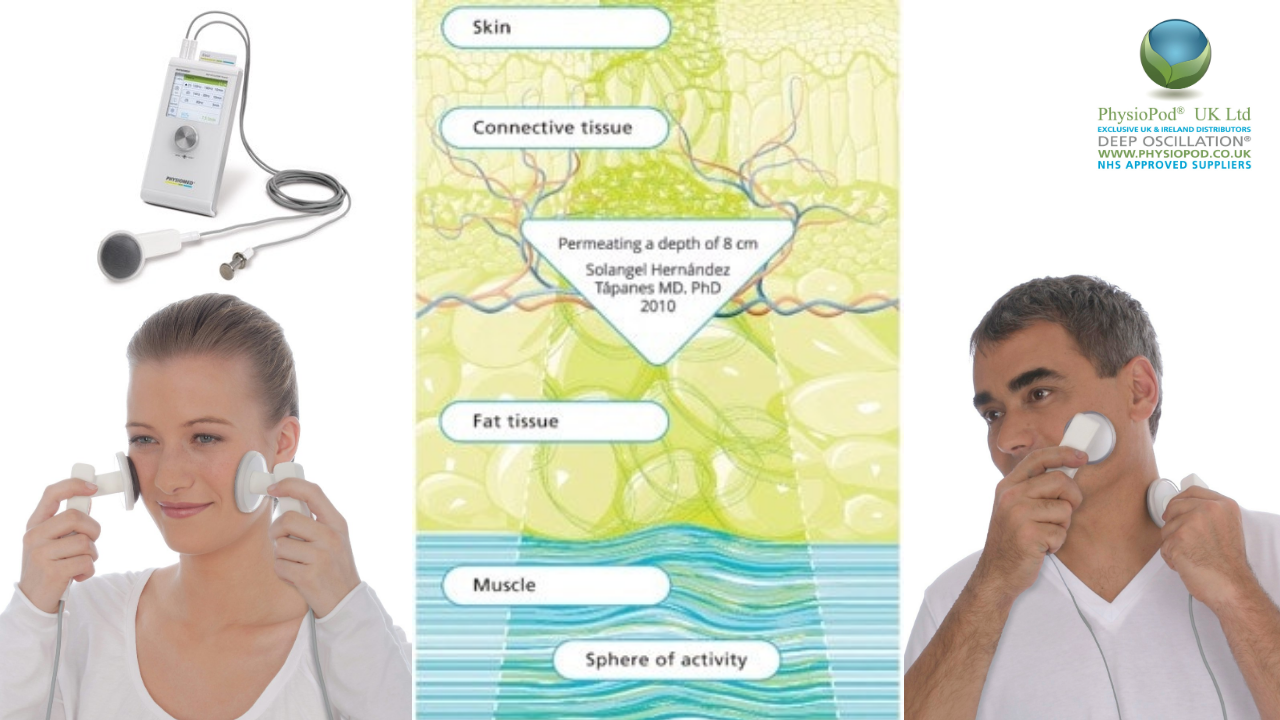
Head and neck lymphoedema is a challenging condition that can significantly affect a person's quality of life effecting upto 90% of individuals on completion of treatment. It often presents with various complex symptoms, impacting physical function, appearance, and emotional well-being. DEEP OSCILLATION® therapy provides a promising adjunct in managing these complex issues.
Individuals living with head and neck lymphoedema may face numerous difficulties, including:
• Airway Obstruction: Severe swelling can lead to compromised breathing and breathing difficulties, which may be lethal in extreme circumstances.
• Dysphagia (Difficulty Swallowing): This condition impairs swallowing, potentially resulting in nutritional difficulties. Patients may also experience odynophagia, or painful swallowing.
• Facial and Neck Disfigurement: Lymphoedema can cause asymmetry of the face or neck, leading to cosmetic disfigurement, facial deformity, or an abnormal facial appearance, which significantly affects how someone looks.
• Pain and Discomfort: Common symptoms include pain or discomfort, which may also manifest as headaches. This pain can arise from swelling, fibrosis, or nerve compression.
• Limited Mobility: There can be a decrease in range of motion, particularly in the cervical spine (neck), leading to limited neck mobility, restricted neck range of motion, and difficulty moving the neck, head, and jaw. This hampers daily activities and reduces quality of life.
• Skin Issues: Cellulitis or Skin Infections: Patients face an elevated risk of persistent cellulitis or skin infections, which are often linked to lymphoedema. Skin Breakdown or Ulceration: Swelling can cause skin damage, leading to skin breakdown or ulceration, sometimes with oozing or bleeding from lesions. Fibrosis and scarring exacerbate this risk.
• Psychological and Emotional Effects: The visible disfigurement, functional limitations, and ongoing medical issues can result in social disengagement, anxiety, emotional distress, increased social isolation, and reduced self-esteem.
• Ocular Difficulties: Severe eyelid lymphoedema can cause difficulty regaining normal ocular aperture (ability to open eyes), potentially leading to vision problems or even effective blindness in extreme cases.
• Speech Difficulties: Individuals may experience modified speech or difficulty speaking, signifying a functional impairment that can impact social interactions and overall quality of life.
How Deep Oscillation Therapy Provides Relief
• Reduces Swelling: This therapy promotes lymphatic drainage, helping to decrease persistent oedema and swelling around the face, neck, and eyes.
• Improves Mobility: By reducing fibrosis and softening scar tissue, deep oscillation can enhance movement of the neck and jaw, alleviating limited range of motion and improving flexibility.
• Relieves Pain and Discomfort: The therapy has analgesic effects, which can ease pain arising from swelling, fibrosis, inflammation, or tissue tightness.
• Enhances Skin Health: Deep oscillation improves circulation, promoting healthier skin and reducing the risk of ulceration, infections, and skin breakdown.
• Reduces Fibrosis and Scar Tissue: It helps in softening fibrotic tissue and scars, improving flexibility, restoring more natural tissue flexibility, and reducing contractures that limit movement.
• Improving Lymphatic Flow and Skin Health: Deep Oscillation can lower the chances of cellulitis and other skin infections, which are common issues for people with lymphoedema.
• Improves Breathing and Speech: Reducing oedema and fibrosis around the airway and oral structures can facilitate better breathing, speech, and swallowing functions, enabling greater independence and quality of life.
• Improved Relocation of Lymph: After lymph nodes have been removed it is necessary to relocate the lymph to other regions in order for it to drain effectively. This distance can be considerable, and the use of Deep Oscillation makes it significantly simpler to relocate to the necessary location than it is to do so manually.
• Psychological Benefits: The reduction in discomfort, aesthetic improvements, and enhanced mobility can significantly boost emotional well-being. Patients often experience increased self-esteem and reduced social isolation.
• Facilitates Tissue Regeneration: The therapy stimulates cellular activity and tissue healing, which can help in repairing damaged tissues, reducing fibrosis, and promoting overall recovery.
Deep oscillation therapy offers a non-invasive, supportive treatment option that can address many of these issues. By reducing swelling and fibrosis, enhancing mobility, alleviating pain, and promoting skin health, deep oscillation therapy can significantly improve the quality of life for individuals managing this complex condition. It serves as a valuable adjunct in tackling the intricate problems associated with head and neck lymphoedema.
ACCESS DEEP OSCILLATION®
SELF CARE
DEEP OSCILLATION® PERSONAL BASIC
MORE QUESTIONS?
READ MORE TESTIMONIALS IN LYMPHOEDEMA MANAGEMENT
